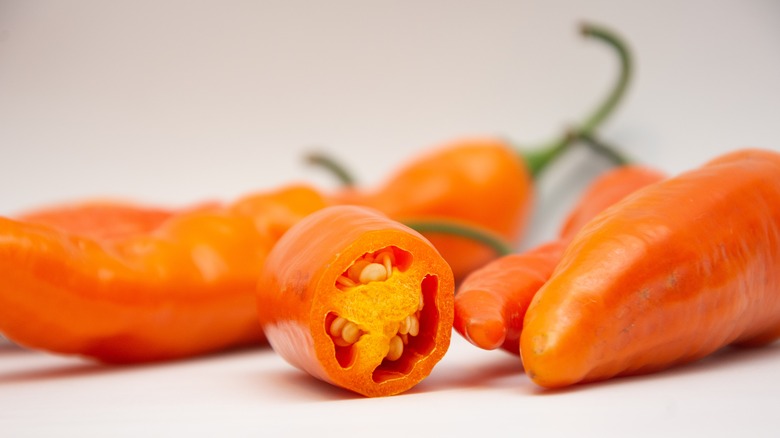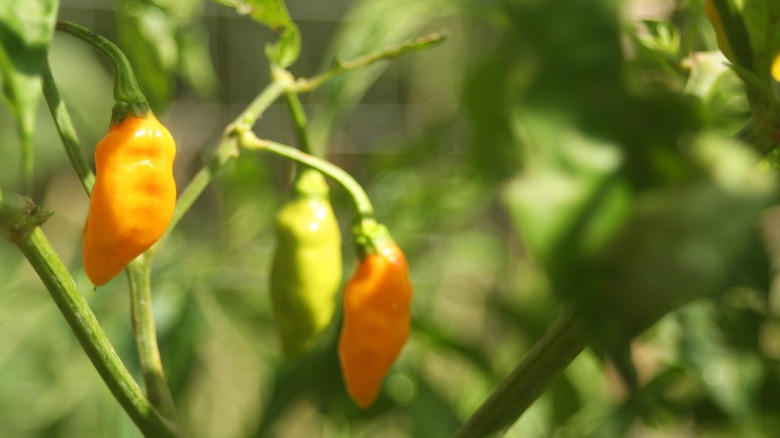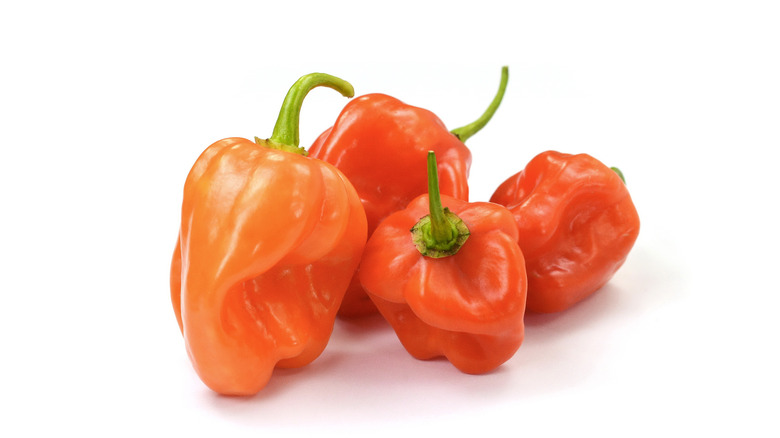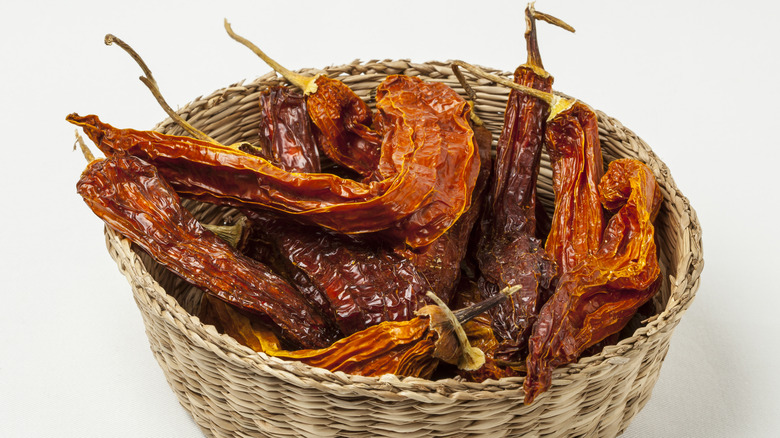Aji Amarillo: The Peruvian Chili Pepper You Should Know
Had any of us been lucky enough to be at the Cordon Bleu in the mid-1990s, we might have encountered world-renowned Peruvian chef Gastón Acurio cooking for his classmates. According to Condé Nast Traveler, Acurio took a break from his French cuisine studies by preparing Peruvian dishes, revealing new flavors and ingredients to up-and-coming chefs. We might have sampled Acurio's aji de gallina, for example, which is shredded chicken in a bright yellow sauce made from one of the staples in Peruvian cuisine: the aji amarillo pepper.
As Peruvian cuisine has spread beyond the country's borders –thanks in no small part to the passionate work of Gastón — so has the aji amarillo, a fiery pepper that both colors and flavors many iconic Peruvian dishes. Serious Eats explains that aji amarillo is one of the many peppers in the Capsicum baccatum species, and its unique flavors, coupled with its importance in Peru's culinary history, make it an ingredient you should definitely know.
What is aji amarillo?
The Capsicum baccatum species, according to Pepper Geek, likely contains thousands of different varieties, and it originated in the Andes mountains of South America. Serious Eats explains that in the U.S., we may be more familiar with peppers from the C. annum family, which includes bell peppers, poblanos, and jalapeños, though any contact with Peruvian cuisine probably included the aji amarillo. Aji, in Spanish, translates as "chili pepper," and amarillo means "yellow," though when the peppers are mature, they turn more orange in color.
The Spruce Eats notes that aji amarillo grows all over the country of Peru and is part of Peruvian cuisine's holy trinity, rounded out by garlic and red onion. Pepper Joe's notes that one thing that differentiates C. baccatum pepper plants from other species is the fact that all the varieties have fuzzy leaves. The plants tend to grow fairly tall, are perennial in the right climates, and the fruit matures relatively late in the season, per Pepper Geek.
What does aji amarillo taste like?
First of all, aji amarillo is hot! Its Scoville scale rating is 30,000-50,000, according to Pepper Scale, which means it's in the same range as cayenne and tabasco peppers. For comparison, the jalapeño pepper rates 2,500-8000 on the Scoville scale, while the habanero and scotch bonnet peppers come in around 100,000-350,000 Scoville heat units. Depending on your heat tolerance, of course, aji amarillo will impart pleasant, noticeable spice to your dish.
As far as aji amarillo's flavor, Serious Eats whets our appetite by explaining, "If there were a chile to taste like sunshine, this would be it." The pepper is fruity, and The Spruce Eats adds that there are notes of raisins, along with tropical notes of mango and passion fruit. So aji amarillo has bright, sunny, fruity notes similar to a habanero, but with more approachable heat levels. Those fruit-forward qualities, coupled with the spice, are part of what distinguishes Peruvian cuisine and makes aji amarillo worth seeking out.
How to cook with aji amarillo
On the table, you're most likely to encounter aji amarillo in a sauce. Aji amarillo sauce, according to The Spruce Eats, can accompany anything from roasted chicken to french fries or fried yuca. It combines aji amarillo, onions, mayonnaise, lime juice, and queso fresco for a creamy, spicy condiment. Aji amarillo also frequently appears in ceviche.
Other classic Peruvian dishes like papas a la Huancaína also feature our fruity aji amarillo. This dish is composed of boiled potatoes, all smothered in a yellow sauce that contains cheese and aji amarillo, for a hearty, simple side that is both satisfying and spicy. Seafood dishes benefit from the heat and tropical flavors of aji amarillo, and it's also ideal for brightening up roasted root vegetables. Feel free to experiment with aji amarillo in other cuisines as well. Have a favorite chili recipe? Throw in an aji amarillo and see how the tropical heat can add subtle complexity.
Where to buy aji amarillo
Keep an eye out for aji amarillo peppers if you have a market with an outstanding pepper selection, as they're a bit of a specialty item in mainstream shops in the U.S. Fortunately, Peruvian or Mexican markets, according to Serious Eats, may also stock them fresh or even frozen.
While tracking down fresh aji amarillo may be difficult, there are plenty of other options — specialty shops like Peruvian markets or even massive online marketplaces like Amazon stock aji amarillo paste. The peppers can also be found in dried or canned varieties. If you find aji amarillo dried, it can be ground and added to chili seasoning or used as a component in a fiery spice rub. Aji amarillo paste is probably the most frequently encountered form of the pepper, making dishes like Gastón Acurio's even easier to master. For the ultimate DIY, Pepper Joe's even sells aji amarillo seeds so you can grow your own spicy, fruity Peruvian peppers in your backyard.




